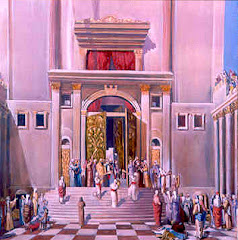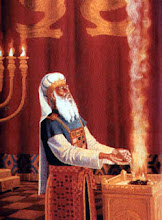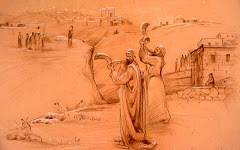Please beware of a frightening custom that has crept into “Orthodox” practice, and spread to nearly every ethnic community of the Jewish People I am aware of: the ‘tefillah la-parnasah’ (prayer for sustenance) before the open ark, in the “merit” of a secret name, whose meaning I will soon reveal. Being the name is not remotely Hebrew, but clearly Spanish, this custom clearly crept into Jewish practice in pre-Inquisition Spain, during the well-documented partnership between pseudo-mequbalim(pseudo-Kabbalists) and the Christian church.
(The following sources are taken from those quoted in Prof. Rabbi Jose Faur’s work, “A Crisis of Categories: Kabbalah and the Rise of Apostasy in Spain.” pp.31 While I do not identify with all the views of the author, some of which I find extreme and unbalanced, the sources he quotes from are greatly important. Namely, I do not share Rabbi Faur’s blanket attack on mystical kabbalah. I believe that both confirmed rationalists and mystics see important sides of the same coin. It is the extremists on both sides of the divide who refuse to consider the other side who frighten me.)
One example of this wicked partnership is seen in the letter written by Rav David Qamhi to Rav Yehudah al-Fakhkhar (d. 1235), the leader of the anti-Maimonideans in Toledo. One of the greatest Hakhamim in Western Europe at the time, he reported on Rav Yonah’s instigation of the burning of RaMBaM’s Book of Knowledge and Guide to the Perplexed. (It must be noted that Rav Yonah spent years in devout teshuvah for evil he’d done. His later remorse is reportedly the inspiration behind his work, “Sha`arei Teshuvah”.) Rav Qamhi wrote:
…he [Rav Yonah] is evil and unlearned…. And became an informer and an enemy collaborator. Because when he realized that the Rabbis in France had rejected him and regarded him as an unlearned person… he turned to the graven images and idol worshipers [i.e. the Church], and implored of them and they consented to help him since he was denouncing the Jews. First he went to the Franciscans telling them: ‘Look, most of our people are heretics and unbelievers, because they were duped by Rav Moshe of Egypt [Maimonides] who wrote heretical books. You exterminate your heretics, exterminate also ours!” Thereafter they ordered to burn those books, which were the Book of Knowledge and the Guide. His uncircumcised heart, however, did not rest until he also told the same words to the Dominicans and the clergy…
This relationship between the church and pseudo-Kabbalists appears to have gone beyond book-burning: The idolatrous concepts of shi`tuf and deification of abstract concepts—hallmarks of Christianity—found their way into “Jewish” thought. The famous mequbal Rav Avraham Abul`afya (1240-1291) remarked:
Accordingly, let me inform you, that the masters of mysticism [and] thesefirot thought to profess the unity of G-d, and escape the doctrine of trinitarianism, and [in fact] they made him ten. In the same fashion that the gentiles say, “He is three and the three are one,” some masters of mysticism say that the divinity is ten sefirot and the ten are one.
Certain quacks from Ashkenzic mystical circles (whose ideas were adopted by mystical quacks from Sefaradi circles) came to believe that the trinity itself represents the truest form of monotheism, Has wa-Shalom (G-d forbid). Rav Solomon ibn Verga (d. ca. 1520) reported on this apostasy, quoting one of their polemics:
But the trinity is not polytheism but simple monotheism to those who understand. And I saw three great men from the Ashkenazic sages and I learned from them in the books of mysticism, and I saw how from there it becomes evident how the trinity is monotheism….
So it should not be too great a surprise that in the ‘tephillah la-parnasah’ (prayer for sustenance) found in about every High Holiday maHzor (prayer book) —Ashkenazi, Sepharadi, even neo-Yemenite— people are praying for sustenance for the coming year in the name of DICARNOSA. Look it up in your maHzor—it’s almost certainly there. (In some Sefardic siddurim it appears as an optional prayer that may be inserted daily in the Amidah, the standing prayer.) Now notehow the Artscroll siddur instructs you NOT TO SAY THE NAME, just to scan it with the eyes… Since the most sacred Name of HaShem, Y-H-W-H, may not be pronounced except by the High Priest on Yom Kippur in a functioning Holy Temple, most Jews don’t see anything abnormal here.
However, anyone who speaks a Latin-based language would be amazed to consider the meaning:
* “Di”, is identical to the Latin “deo”, or in English, “deity”–meaning “God”.
* “Carne” is Spanish for meat or flesh, to this day. It is the root of the word “carnivore”—a meat-eater.
* The suffix “-oso” marks “carne” as an adjective, so that it means “meaty”, “fleshy”, or “corpulent.” This is clear when you see the same suffix in other common Spanish adjectives that end in “oso” or “osa”, such as in “maravilloso” (marvelous), or “delicisioso” (delicious).
In other words, in simple Spanish, DI-CARNOSA simply means, “God in the flesh”.
— The religion that teaches how God Almighty became flesh and lived on earth as a physical man, of course, is Christianity.
— It is the same religion whose tentacles penetrated penetrated European Jewish scholarship, censoring the sacred Oral Torah literature, namely the Talmud and Mishneh Torah. This is well known. (Besides removing negative references to Jesus, the Church’s agents — usually Jewish scholars who converted — ensured that laws offensive to Christians would become worded as “`ovde kokhavim u-mazaloth” — star worshippers — removing Christianity from a negative light.) It is the
— It is the same religion that influenced the spiritual doctrines taught by corrupted Jewish scholars in Spain and France, as we see above. That is why those who maintained the ancient mutsa`arab prayer tradition — namely Jews of the Andalusian and old Yemenite schools — never recited this prayer of the Franco-Northern Spanish Jews.
All evidence points to DI-CARNOSA being another name for Jesus.
Nearly all evidence, that is. In fairness to the brilliant scholar, it must be noted that Rabbi Faur understands “Dicarnosa” to be a form of “Dea Cornosa”, meaning “fleshy goddess” in Spanish. His logic is as follows: Latin for god is “deus”, not “deo”. Hence Mozart’s middle name “Amadeus”. Pre-Christian fertility/grain goddesses were often portrayed as corpulent women. Therefore he understands “corpulent goddess” to be the origin of the name of the foreign divinity in the prayer for sustenance.
However, considering that this practice hails from the lands where Jews were so greatly intimidated, pressured, scrutinized, and influenced by the powerful Catholic church — and not by pre-Christian pagan cultists — I believe it is “God in the flesh” that penetrated the siddur: not “corpulent goddess.”
In truth, it makes no difference whatsoever. Is one of the above possibilities preferable over the other??
Please don’t say this prayer. Besides the well-known, recorded invasion of Christian theology into certain quack rabbinical, mystical circles; it appears nowhere throughout the whole breadth of the Written Torah [Bible] and Oral Torah literature. Even if you still have a doubt — insisting on believing in all innocence that this must be a “sacred Name” that somehow sounds just like “God in the flesh” or “corpulent goddess” — this is no matter on which to be lenient. We’re talking about unwittingly praying to HaShem in the name of a foreign deity.
May HaShem bless Israel with a year of prosperity—but if He does, it will certainly not be in the merit of a name from idolatry. In fact, according to the Rambam, we are not to make special requests for anything on Shabboth and Haggim, outside the prayers instituted by Haza”l (the Talmudic Sages), except for specific, dire emergency situations.
SOURCE; http://www.torathmoshe.com/2008/09/the-meaning-of-real-teshuvah-to-the-berith-covenant-torath-moshe/











No hay comentarios:
Publicar un comentario